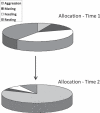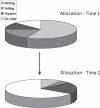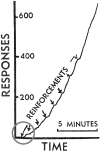Rethinking reinforcement: allocation, induction, and contingency
- PMID: 22287807
- PMCID: PMC3266735
- DOI: 10.1901/jeab.2012.97-101
Rethinking reinforcement: allocation, induction, and contingency
Abstract
The concept of reinforcement is at least incomplete and almost certainly incorrect. An alternative way of organizing our understanding of behavior may be built around three concepts: allocation, induction, and correlation. Allocation is the measure of behavior and captures the centrality of choice: All behavior entails choice and consists of choice. Allocation changes as a result of induction and correlation. The term induction covers phenomena such as adjunctive, interim, and terminal behavior-behavior induced in a situation by occurrence of food or another Phylogenetically Important Event (PIE) in that situation. Induction resembles stimulus control in that no one-to-one relation exists between induced behavior and the inducing event. If one allowed that some stimulus control were the result of phylogeny, then induction and stimulus control would be identical, and a PIE would resemble a discriminative stimulus. Much evidence supports the idea that a PIE induces all PIE-related activities. Research also supports the idea that stimuli correlated with PIEs become PIE-related conditional inducers. Contingencies create correlations between "operant" activity (e.g., lever pressing) and PIEs (e.g., food). Once an activity has become PIE-related, the PIE induces it along with other PIE-related activities. Contingencies also constrain possible performances. These constraints specify feedback functions, which explain phenomena such as the higher response rates on ratio schedules in comparison with interval schedules. Allocations that include a lot of operant activity are "selected" only in the sense that they generate more frequent occurrence of the PIE within the constraints of the situation; contingency and induction do the "selecting."
Keywords: Phylogenetically Important Event; allocation; contingency; correlation; inducer; inducing stimulus; induction; reinforcement; reinstatement.
Figures

















Similar articles
-
Matching theory and induction explain operant performance.J Exp Anal Behav. 2020 Mar;113(2):390-418. doi: 10.1002/jeab.583. Epub 2020 Feb 9. J Exp Anal Behav. 2020. PMID: 32037561
-
Multiscale behavior analysis and molar behaviorism: An overview.J Exp Anal Behav. 2018 Nov;110(3):302-322. doi: 10.1002/jeab.476. Epub 2018 Oct 9. J Exp Anal Behav. 2018. PMID: 30302758 Review.
-
Competition between stimulus-reinforcer contingencies and anticipatory contrast.J Exp Anal Behav. 1992 Sep;58(2):287-302. doi: 10.1901/jeab.1992.58-287. J Exp Anal Behav. 1992. PMID: 1402603 Free PMC article.
-
Signal functions in delayed discriminative stimulus control by reinforcement sources.J Exp Anal Behav. 2014 May;101(3):355-72. doi: 10.1002/jeab.85. Epub 2014 Apr 3. J Exp Anal Behav. 2014. PMID: 24700527
-
Operant variability: evidence, functions, and theory.Psychon Bull Rev. 2002 Dec;9(4):672-705. doi: 10.3758/bf03196324. Psychon Bull Rev. 2002. PMID: 12613672 Review.
Cited by
-
Information: theory, brain, and behavior.J Exp Anal Behav. 2013 Nov;100(3):408-31. doi: 10.1002/jeab.49. Epub 2013 Oct 4. J Exp Anal Behav. 2013. PMID: 24122456 Free PMC article.
-
What Counts as Behavior? The Molar Multiscale View.Behav Anal. 2013 Fall;36(2):283-293. doi: 10.1007/BF03392315. Behav Anal. 2013. PMID: 28018040 Free PMC article.
-
Vernacular Selection: What to Say and When to Say It.Anal Verbal Behav. 2018 Aug 24;34(1-2):62-78. doi: 10.1007/s40616-018-0097-y. eCollection 2018 Dec. Anal Verbal Behav. 2018. PMID: 31976215 Free PMC article.
-
Editorial: Emerging Cultural and Behavioral Systems Science.Perspect Behav Sci. 2019 Dec 2;42(4):699-711. doi: 10.1007/s40614-019-00237-8. eCollection 2019 Dec. Perspect Behav Sci. 2019. PMID: 31976456 Free PMC article. No abstract available.
-
Moving Beyond Reinforcement and Response Strength.Behav Anal. 2017 Jun 19;40(1):107-121. doi: 10.1007/s40614-017-0092-y. eCollection 2017 Jun. Behav Anal. 2017. PMID: 31976956 Free PMC article.
References
-
- Allison J. Behavioral economics. New York: Praeger; 1983.
-
- Allison J, Miller M, Wozny M. Conservation in behavior. Journal of Experimental Psychology: General. 1979;108:4–34.
MeSH terms
LinkOut - more resources
Full Text Sources

